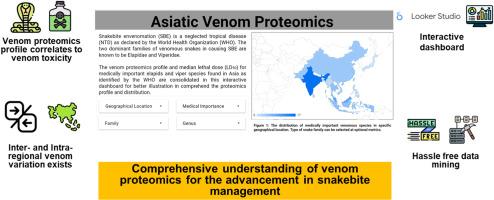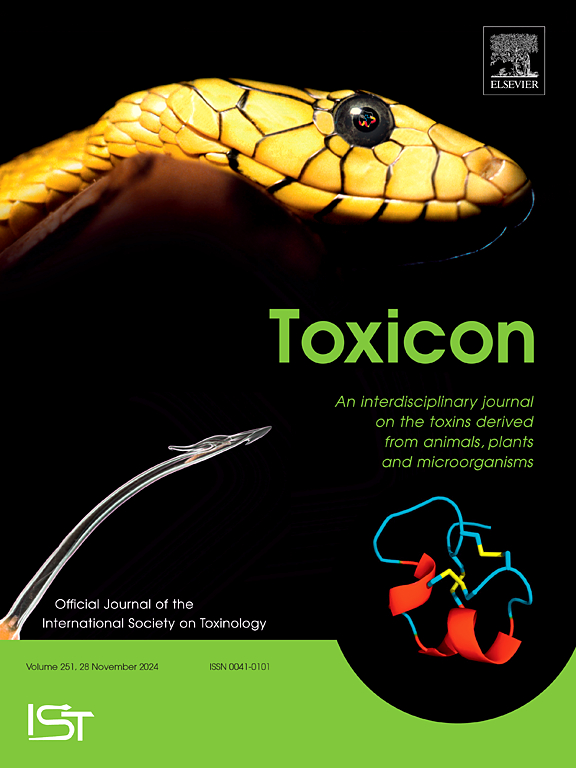Deciphering toxico-proteomics of Asiatic medically significant venomous snake species: A systematic review and interactive data dashboard
IF 2.6
4区 医学
Q2 PHARMACOLOGY & PHARMACY
引用次数: 0
Abstract
Snakebite envenomation (SBE) is a neglected tropical disease (NTD) with an approximate 1.8 million cases annually. The tremendous figure is concerning, and the currently available treatment for snakebite envenomation is antivenom. However, the current antivenom has limited cross-neutralisation activity due to the variations in snake venom composition across species and geographical locations. The proteomics of medically important venomous species is essential as they study the venom compositions within and among different species. The advancement of sophisticated proteomic approaches allows intensive investigation of snake venoms. Nevertheless, there is a need to consolidate the venom proteomics profiles and distribution analysis to examine their variability patterns. This review systematically analysed the proteomics and toxicity profiles of medically important venomous species from Asia across different geographical locations. An interactive dashboard - Asiatic Proteomics Interactive Datasets was curated to consolidate the distribution patterns of the venom compositions, serve as a comprehensive directory for large-scale comparative meta-analyses. The population proteomics demonstrate higher diversities in the predominant venom toxins. Besides, inter-regional differences were also observed in Bungarus sp., Naja sp., Calliophis sp., and Ophiophagus hannah venoms. The elapid venoms are predominated with three-finger toxins (3FTXs) and phospholipase A2 (PLA2). Intra-regional variation is only significantly observed in Naja naja venoms. Proteomics diversity is more prominent in viper venoms, with widespread dominance observed in snake venom metalloproteinase (SVMP) and snake venom serine protease (SVSP). Correlations exist between the proteomics profiles and the toxicity (LD50) of the medically important venomous species. Additionally, the predominant toxins, alongside their pathophysiological effects, were highlighted and discussed as well. The insights of interactive toxico-proteomics datasets provide comprehensive frameworks of venom dynamics and contribute to developing antivenoms for snakebite envenomation. This could reduce misdiagnosis of SBE and accelerate the researchers' data mining process.

解密亚洲医学上重要毒蛇物种的毒物蛋白质组学:系统综述和交互式数据仪表板。
蛇咬伤(SBE)是一种被忽视的热带疾病(NTD),每年约有 180 万病例。这一巨大数字令人担忧,目前治疗蛇咬伤的方法是注射抗蛇毒血清。然而,由于不同物种和不同地理位置的蛇毒成分存在差异,目前的抗蛇毒血清的交叉中和活性有限。医学上重要毒物物种的蛋白质组学研究至关重要,因为它们研究了不同物种内部和不同物种之间的毒液成分。先进的蛋白质组学方法可以对蛇毒进行深入研究。尽管如此,仍有必要对毒液蛋白质组学概况和分布分析进行整合,以研究其变异模式。本综述系统分析了亚洲不同地理位置的重要医疗毒物的蛋白质组学和毒性特征。为了整合毒液成分的分布模式,我们设计了一个交互式仪表板--亚洲蛋白质组学交互式数据集,作为大规模比较荟萃分析的综合目录。种群蛋白质组学显示,主要毒液毒素的多样性较高。此外,在 Bungarus sp.、Naja sp.、Calliophis sp.和 Ophiophagus hannah 毒液中也观察到了区域间差异。伶鼬毒液中主要是三指毒素(3FTX)和磷脂酶 A2(PLA2)。只有在 Naja naja 毒液中才能观察到明显的区域内差异。在蝰蛇毒液中,蛋白质组学的多样性更为突出,蛇毒金属蛋白酶(SVMP)和蛇毒丝氨酸蛋白酶(SVSP)广泛占据主导地位。蛋白质组学特征与医学上重要毒物的毒性(半数致死剂量)之间存在相关性。此外,还强调并讨论了主要毒素及其病理生理效应。交互式毒物蛋白质组学数据集提供了毒液动态的全面框架,有助于开发蛇咬伤毒液的抗蛇毒血清。这可以减少对蛇咬伤的误诊,加快研究人员的数据挖掘过程。
本文章由计算机程序翻译,如有差异,请以英文原文为准。
求助全文
约1分钟内获得全文
求助全文
来源期刊

Toxicon
医学-毒理学
CiteScore
4.80
自引率
10.70%
发文量
358
审稿时长
68 days
期刊介绍:
Toxicon has an open access mirror Toxicon: X, sharing the same aims and scope, editorial team, submission system and rigorous peer review. An introductory offer Toxicon: X - full waiver of the Open Access fee.
Toxicon''s "aims and scope" are to publish:
-articles containing the results of original research on problems related to toxins derived from animals, plants and microorganisms
-papers on novel findings related to the chemical, pharmacological, toxicological, and immunological properties of natural toxins
-molecular biological studies of toxins and other genes from poisonous and venomous organisms that advance understanding of the role or function of toxins
-clinical observations on poisoning and envenoming where a new therapeutic principle has been proposed or a decidedly superior clinical result has been obtained.
-material on the use of toxins as tools in studying biological processes and material on subjects related to venom and antivenom problems.
-articles on the translational application of toxins, for example as drugs and insecticides
-epidemiological studies on envenoming or poisoning, so long as they highlight a previously unrecognised medical problem or provide insight into the prevention or medical treatment of envenoming or poisoning. Retrospective surveys of hospital records, especially those lacking species identification, will not be considered for publication. Properly designed prospective community-based surveys are strongly encouraged.
-articles describing well-known activities of venoms, such as antibacterial, anticancer, and analgesic activities of arachnid venoms, without any attempt to define the mechanism of action or purify the active component, will not be considered for publication in Toxicon.
-review articles on problems related to toxinology.
To encourage the exchange of ideas, sections of the journal may be devoted to Short Communications, Letters to the Editor and activities of the affiliated societies.
 求助内容:
求助内容: 应助结果提醒方式:
应助结果提醒方式:


